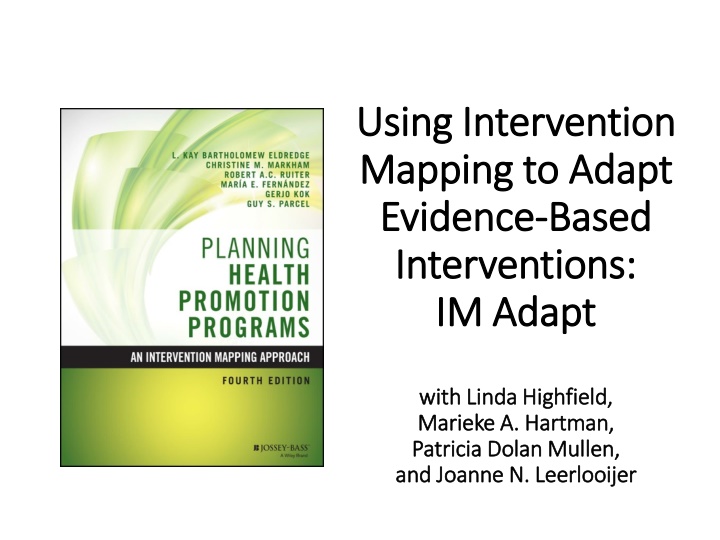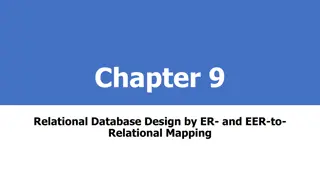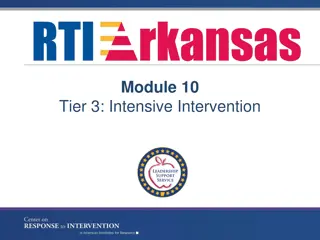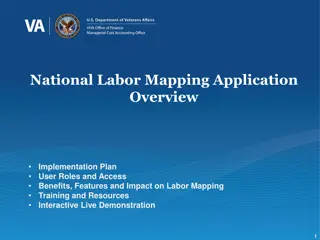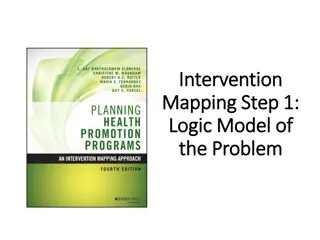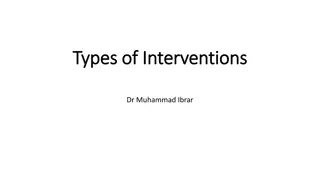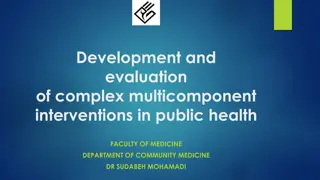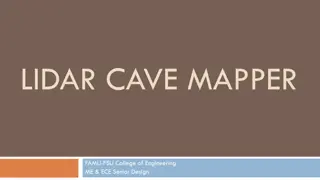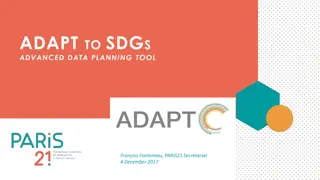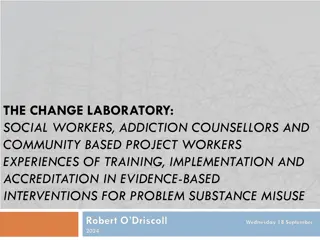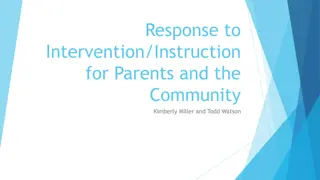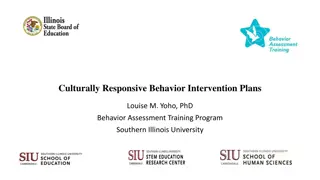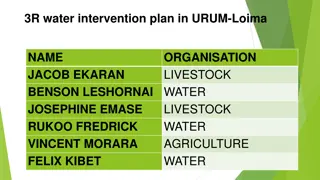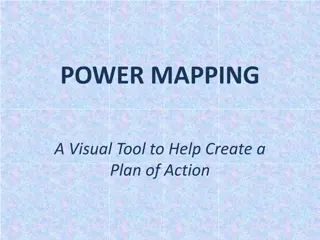Using Intervention Mapping to Adapt Evidence-Based Interventions
In this comprehensive guide, learn how to systematically adapt evidence-based interventions (EBIs) to new settings while retaining critical elements for effectiveness. Tasks involve needs assessment, logic model development, searching for EBIs, assessing fit, planning adaptations, implementation, and evaluation. Conducting a needs assessment, assessing organizational capacity, creating logic models, and searching for EBIs are key steps outlined in the process.
Download Presentation

Please find below an Image/Link to download the presentation.
The content on the website is provided AS IS for your information and personal use only. It may not be sold, licensed, or shared on other websites without obtaining consent from the author.If you encounter any issues during the download, it is possible that the publisher has removed the file from their server.
You are allowed to download the files provided on this website for personal or commercial use, subject to the condition that they are used lawfully. All files are the property of their respective owners.
The content on the website is provided AS IS for your information and personal use only. It may not be sold, licensed, or shared on other websites without obtaining consent from the author.
E N D
Presentation Transcript
Using Intervention Using Intervention Mapping to Adapt Mapping to Adapt Evidence Evidence- -Based Interventions: Interventions: IM Adapt IM Adapt Based with Linda with Linda Highfield Marieke Marieke A. Hartman, A. Hartman, Patricia Dolan Mullen Patricia Dolan Mullen, , and Joanne N. and Joanne N. Leerlooijer Highfield, , Leerlooijer
Overview Because of the importance of a balance between fidelity to original program design and adaptation to help an intervention better suit a new setting, changes to EBIs should be undertaken systematically with an eye to retention of the critical elements that made the program effective in the first place 2
Tasks for IM Adapt Conduct a needs assessment, and develop logic models for the problem and for change Search for evidence-based interventions (EBIs) Assess fit and plan adaptation Make adaptations Plan for implementation Plan for evaluation
Adapting an EBI INSERT FIGURE 10.1 HERE Figure 10.1 4
Task 1: Conduct a Needs Assessment, Assess Organizational Capacity, and Create Logic Models Conduct a needs assessment for the new site or population to develop a logic model of the problem Develop a logic model of change What needs to change as a result of the program? Assess organizational capacity Does the mission of the organization coincide with the goals of the intervention? What budget is available for this project? What is the organization s readiness for implementing this program? 5
Logic Model of the Problem INSERT FIGURE 10.2 HERE Figure 10.2 6
Logic Model of Change INSERT FIGURE 10.3 HERE Figure 10.3 7
Task 2: Search for Evidence-based Interventions (EBIs) Search for an EBI Literature reviews Websites for full EBIs Websites for general intervention strategies Judge basic fit to creat a short list of interventions to carry forward to Step 3 Health problem and health promoting behavior fit Priority population fit Organizational capacitiy fit 8
Task 3: Assess Fit and Plan Adaptation Make final decision about which program to implement More detailed judgement of fit for each program Behavioral and environmental fit Change methods and determinants fit Delivery fit, design features, and cultural fit Consider essential program elements and how to retain them List adaptations needed 9
Task 4: Make Adaptations Prepare design documents for adaptation If proposed changes include additional determinants or change method, may need to prepare a minimatrix Pretest adapted materials Produce final adaptations 10
Task 5: Plan for Implementation Identify implementers, behaviors, and outcomes Delivered to whom? By whom? When? How much? Develop implementation and maintenance scope, sequence, and instructions Plan activities to motivate and train implementers E.g., trainings, consultation, and technical support activities 11
Task 6: Plan for Evaluation An overriding purpose to evaluating an adapted EBI is to determine whether the intervention achieves the same results in the new setting with the changes that have been made (effect evaluation) Write effect and process evaluation questions Choose indicators and measures Choose an evaluation design Plan data collection, analysis, and reporting 12
Case Study Adapting an EBI to Enhance Mammography Screening among African American women 13
Task 1: Conduct a Needs Assessment, Assess Organizational Capacity, and Create Logic Models African American women face disparities in mammography rates and mortality rates from breast cancer compared to other racial/ethnic groups in Houston, TX Among women with mammogram appointments, African American women miss appointments at a higher rate 14
Planning Group A local hospital-based charity organization Breast cancer provider organizations Local breast health collaborative Local school of public health They conducted: A literature review Local data collection An organizational capacity review 15
Logic Model of the Problem INSERT FIGURE 10.5 HERE Figure 10.5 16
Logic Model of Change INSERT FIGURE 10.6 HERE Figure 10.6 17
Task 2: Search for Evidence-based Interventions (EBIs) Searched for an EBI Looked at Community Guide Searched for a program using RTIPS Found articles on three additional programs Judged basic fit to creat a short list Identified a telephone counseling program Breast Cancer Screening among Non-adherent Women (Lipkus et al, 2000) Lipkus, I. M., Rimer, B. K., Halabi, S., & Strigo, T. S. (2000). Can tailored interventions increase mammography use among HMO women? American Journal of Preventive Medicine, 18(1), 1 10. 18
Task 3: Assess Fit and Plan Adaptation The planning group reviewed the program manual (implementation instructions and telephone counseling scripts) to assess: Behavioral and environmental fit Need to adapt from mammogram in general to appointment keeping specifically Change methods and determinants fit Need to enhance determinants and change methods related to stage of change Precontemplation/contemplation Preparation/action Need to include change methods of persuasion, cultural congruence, problem solving, modeling, and guided practice 19
Continued. Delivery fit, design features, and cultural fit Telephone delivery acceptable Scripts for barriers did not target exact concerns of local African American women Recommended active-listening framework for scripts to enhance rapport Considered essential program elements and how to retain them 20
Task 4: Make Adaptations Prepared design documents for adaptation Noted the planned change Described the program materials and activities in which change should be made Wrote or edited messages to support the change 21
Partial Adaptation To-Do List INSERT FIRST PAGE (or LEGIBLE PORTION) OF TABLE 10.3 HERE Table 10.3 22
Example from Design Document INSERT FIRST PAGE (or LEGIBLE PORTION) OF TABLE 10.4 HERE Table 10.4 23
Pretesting and Producing Adapted Materials Pretesting telephone counseling scripts 14 African American women worked in pairs to role-play the scripts (navigator/caller and patient roles) Noted any script changes Produced revised manual of barriers and foundational conversation scripts in hardcopy form After an initial evaluation study, the manual was converted to computer-assisted scripts for use by a live navigator 24
Task 5: Plan for Implementation Identified implementers as patient navigators or community health workers familiar with making reminder calls Implementers would make standard reminder calls as well as protocol-driven, barrier-focused counseling calls to African American women already scheduled for a mammogram Clinical partners would provide navigators with space and access to appointment records Specified implementation outcome At least 100 standard reminder calls and 100 EBI calls in 12 months 25
Continued Scope of the EBI was one completed call per woman Assessment of stage Query regarding barriers Solutions to barriers based on barrier scripts Active listening the glue for moving conversations forward Motivating and training implementers Developed training manual with scripts for opening, moving, and closing conversations, and barrier scripts Training sessions with informal role-play practice to enhance implementers self-efficacy, outcome expectations and skills 26
Task 6: Plan for Evaluation Evaluation aims: Determine effectiveness of the adapted EBI to improve appointment keeping for mammography in African American women Describe the processes of implementation of the adapted EBI in a practice setting 27
Effect Evaluation Questions What was the effectiveness in decreasing appointment no-show rates in the new setting? How did the effectiveness of the adapted EBI in improving appointment-keeping compare to the effectiveness of the original EBI in improving mammography rates among non-adherent women? 28
Process Evaluation Questions Was the adapted EBI delivered to the intended population? Did the implementers follow the protocol? What barriers were discussed in the phone calls? Did women who received the adapted EBI find it helpful and acceptable? What problems occurred during implementation of the adapted EBI? 29
Indicators and Measures Effectiveness Kept and missed appointments obtained from clinical partner s electronic database Implementation fidelity Monitored intervention phone calls and compared to protocol Site visits to clinical partner Post-intervention phone calls to randomly selected patients receiving the intervention Assessed perception of EBI calls Systems barriers encountered Recommended improvements to the program
Evaluation Design Random assignment was not feasible Assigned contacted women to usual care or adapted EBI in sequential groups of 50 patients Enrolled African American women ages 35-64 years, uninsured, income < 200% federal poverty level, with an upcoming mammogram appointment Identified eligible patients from electronic scheduling records 31
Project Outcomes and Current Status The evaluation for this project was completed and the results were used to acquire funding for a larger implementation of the adapted EBI Effectiveness results were in range with results from the original EBI evaluation Women were approached at 41 mammography sites in 8 counties Participants reported positive interactions with navigators and reported numerous things about the phone call that helped them attend their appointment 32
Summary IM Adapt comprises 6 key tasks: 1.Conduct a needs assessment, and develop logic models for the problem and for change 2.Search for evidence-based interventions (EBIs) 3.Assess fit and plan adaptation 4.Make adaptations 5.Plan for implementation 6.Plan for evaluation
